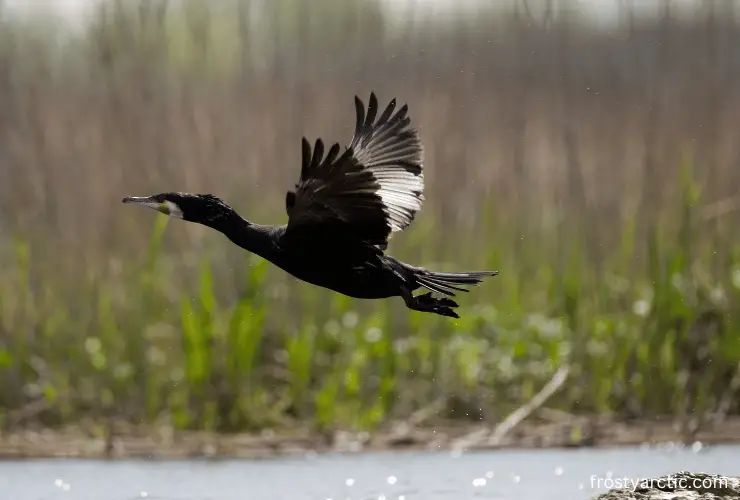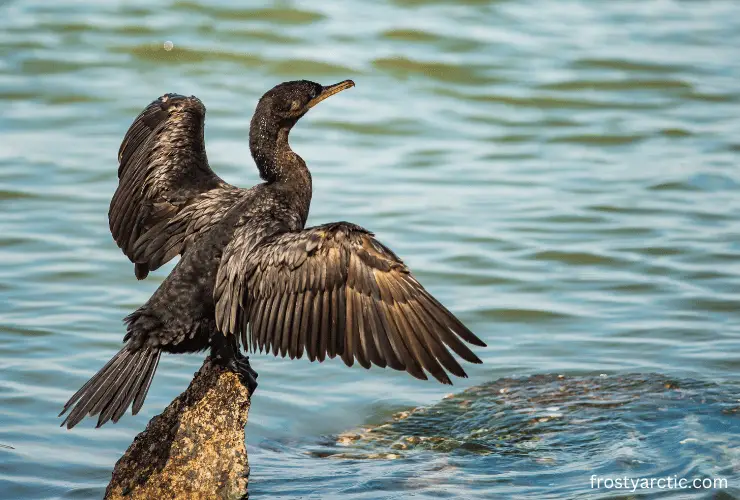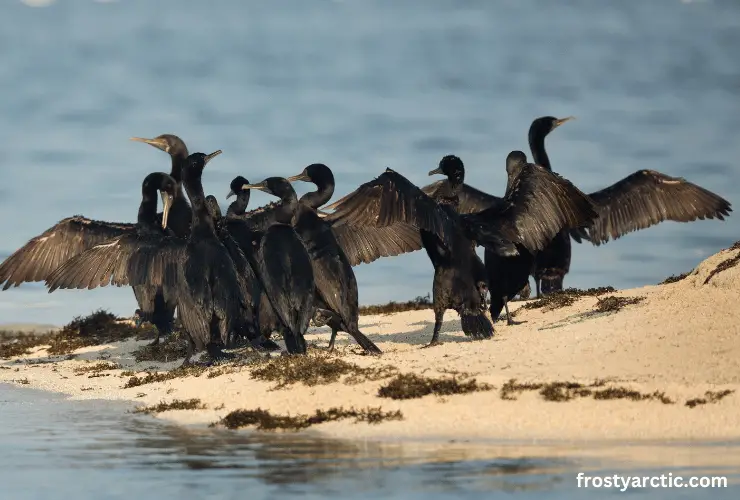Yes, most cormorant species mate for life. They are monogamous birds that choose a single cormorant of the opposite sex to share the same nest for the rest of their lives. Monogamous birds are rarely seen changing their partners unless one pair dies or detaches from the colony.
Cormorants are quite social beings. They have some strict rules and instincts inherited genetically. They cannot go against the rule and stay with the colony by having separate nests for each pair. Ultimately, a cormorant can have only one partner at a time.
The life cycle of a mature cormorant couple is quite interesting as partners distribute the works of nesting between each other and try to keep the offspring safe from predators as ideal parents.
Below, there are more interesting facts that you might not know about cormorants and their lifespan.
How Do Cormorants Live?
Cormorants live in colonies. A colony of cormorants can consist of around 3000-4000 cormorants consisting of both chicks and adults.
The impact of being socialized is clearly seen in the life cycle of a cormorant. A cormorant from any colony chooses a partner for mating from the same colony at 2-4 years old. It would also tend to make a nest with the partner around other previously built nests from the colony.
Usually, cormorants go hunting or fishing in flocks. They look for those areas where they need to work less to find and hunt down prey. Their nests are also near those fertile locations.
Almost every cormorant starts to hunt with other colony members after aging for .5 years or so. Until then, they depend on their parents mostly.

When the cormorants start to catch fish and other small water beings, they tend not to go into the deep water. Most of the time, these newly matured birds stay in the 3-5 km range from the bank or coast.
As cormorants don’t live more than 3 decades, they either stop competing for food with colony members or migrate with some other birds when they become very old.
Most old cormorants leave the area near the ground and nest on higher cliffs. They look for easier ways to survive rather than work harder like others in their last stages of life.
Do Cormorants Mate for Life?
Cormorants mate for life, except for some rare exceptions. They tend to choose one partner for the breeding season and return to the same every year when they can successfully mate for reproduction.
When a male cormorant turns around 2 years old, it looks for a suitable nesting location and attracts adult female birds. A male bird spreads its wings and shows the white marks on the thighs that show the maturity for reproduction.
By answering the call of a male cormorant, the female cormorant comes near the male and does some exotic movement that indicates that they prefer each other and would go for a clutch this year.
If the mating becomes successful at the first attempt, they’d prefer each other again for the next year in the same location. Otherwise, the cormorant pair changes its location and looks for a better breed environment.
In some cases, a cormorant might change the mating partner when the previous relationship fails to give birth to a new generation.
So, cormorants mainly have monogamous nature and prefer to have one partner at a time.
What Do Cormorants Do When their Mate Dies?
Many monogamous birds mourn for quite a long time when they lose their partners. It happens specifically in coastal sea birds that live in colonies.
Most of the time, the mourning period remains for a couple of years or so. But in the case of cormorants, it’s not completely proven whether they mourn the death of their partners or not. Because almost every cormorant species mates once a year.
But, indeed, cormorants don’t change partners instantly, even if the previous partner is alive and unable to reproduce. They wait for some time and look for a new partner to share nests.
In short, an adult cormorant doesn’t stay single unless they are infertile. Adults would look for new partners or respond to the call of mating and nesting when the previous partners die.
When Do Cormorants Breed?
Cormorants prefer breeding in warmer environments. That’s why species in North America and other tropical areas breed before August.
But sometimes, they breed and nest in unusual times, like early January or late October. It happens when pairs of a colony fail to keep the clutches alive or notice the previous environment is unsuitable and migrate.
Besides, the breeding varies depending on the specie. Each specie of cormorant has a different time to pair up and breed. So, it’s hard to specify the exact time of breeding.
How Do Cormorants Reproduce?
Cormorants reproduce sexually.
Both male and female cormorants become sexually mature by the age of 2-3. At that time, male cormorants pick a spot for nesting, not too much off the ground level (older males pick higher spots). Young males tend to pick spots where other nests are also nearby.
After choosing the spot, a male cormorant calls or advertise to attract female. When the male finally gets his call heard and has a pair, the couple starts to make the nest first.

Then, the male cormorant appeals for intercourse at the right time and rides over the female. The male transfers sperm in the female bird’s ovary through cloacae.
The fertilization process then creates eggs in the ova of the female. After that, the female would lay eggs within a few days.
By this, the fertilization or breeding period ends, and the couple starts to nurture the next generation through courtship relations.
How Many Eggs Do Cormorants Lay?
The fertility of a cormorant couple depends on the availability of food and survivability conditions.
If the area of the colony is secure and there’s no food scarcity, a female cormorant can lay around 3-5 eggs in a breeding season. Although the usual nests of cormorants seem to have the capacity of 7 eggs at once, most cormorant families can’t reproduce some eggs at a time.
How Do Male Cormorants Attract Females?
Male cormorants have some unique types of dance moves to attract females.
Males spread their wings higher and showed their colorful feathers clearly. While doing so, they make gargling-type sounds to call the females. Any female who gets attracted to the sound and the color of the feather comes near the male and shows acceptance through body language.
FAQs
Where do cormorants nest?
Cormorants near shores so that they can catch fish easily. Mostly, you can find cormorant nests on artificial ruins, rocks, cliffs, grounds, and sometimes trees.
Are cormorants friendly?
Cormorants are friendly with fellow colony members. Sometimes, they also share hunting trips with other non-hostile birds living on fish. But cormorants always avoid being near human presence.
Are cormorants aggressive?
Cormorants are aggressive, but only towards their prey. They can’t win a fight with larger predators like eagles. So, in a way, they aren’t most likely aggressive like other sea predators.
Summary
All cormorant species believe in the courtship relation. And they always stay dedicated to the breeding partner if there’s no complication. Because of that, it’s scientifically said that cormorants mate for life and never leave their partner till death.
But we already said earlier that there are some exceptions. For example, if a cormorant sees the breeding is unsuccessful with the existing partner, it shifts the courtship relation with another cormorant of the opposite sex. Otherwise, the pair lasts till death.



2 thoughts on “Do Cormorants Mate for Life?”